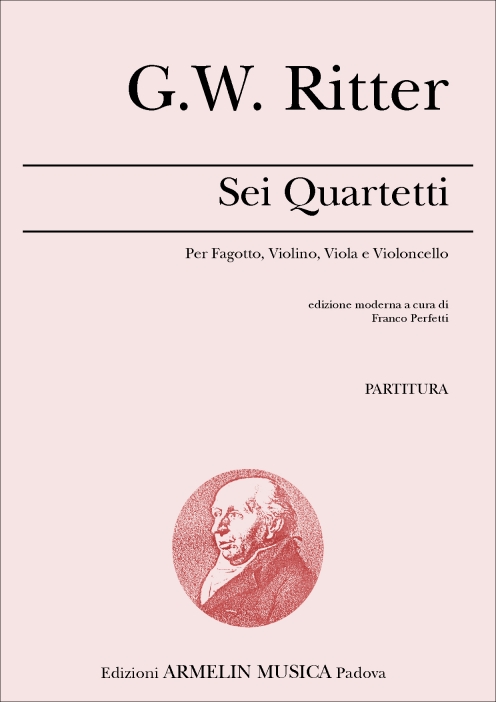Ritter, Georg Wenzel
1748-1808
6 Quartetti
Per Fagotto, Violino, Viola e Violoncello. Partitura
€40,00
Organico:
PDM 068
9790215810983
21,5x31
76
Perfetti, Franco
Armelin Musica
PREFAZIONE
Gli originali si trovano presso la “Biblioteca Musicale Opera Pia G. GREGGIATI” del Comune di Ostiglia (Mantova), ai quali vanno i nostri ringraziamenti per averci accordato il permesso di studio e di pubblicazione.
L’opera composta da Georg Wenzel Ritter, fagottista e compositore (Mannheim 7 Aprile 1748 – Berlino 16 Giugno 1808), risale al 1777 ed è dedicata a “LE MARQUIS DE TURPIN”.
Questa stampa d’epoca priva di partitura, edita ed autografata da Sieber, comprende sei quartetti per Fagotto, Violino, Viola e Violoncello, con relative parti staccate (1), nelle rispettive tonalità di DO Maggiore, Fa Maggiore, SI b Maggiore, MI b Maggiore, SOL Maggiore e FA Maggiore,.
Ritter fu membro dell’orchestra di Mannheim dal 1764 al 1778 alternando la sua opera alla corte di Monaco come secondo fagotto fino al settembre 1788 (2).
Nel 1777 conobbe Mozart , il quale scrisse per lui, nell’ aprile del 1778 a Parigi, la parte di fagotto solista della Sinfonia Concertante kAnh. 9/297B (lettera del 5 Aprile del 1778) (3).
Ritter lavorò in seguito a Potsdam e , dall’ottobre del 1778, divenne membro dell’orchestra di corte di Berlino al servizio di Federico Guglielmo II con un compenso, considerevole per l’epoca, di 1600 Talleri o 6000 Franchi Francesi (secondo le notizie di M. de Ledebur dal “Tonkunstler-Lexikon” Berlino p 70).
Un articolo del Musikalische Real-Zeitung (Speyer, 1788, n. 13) lo descrive come uno dei più grandi virtuosi del fagotto, evidenziando lo speciale stipendio che percepiva a Berlino.
Oltre a Sieber l’editore parigino Bailleux pubblicò due suoi concerti per fagotto e orchestra.
F. W. Bollinger lo ritrasse a Berlino nel 1805.
Georg Wenzel Ritter fu, inoltre, un grande didatta contribuendo alla formazione di quelli che furono tra i più grandi fagottisti tedeschi dell’epoca come Georg Friedrich Brandt (1773-?), suo allievo a Berlino, per il quale C. M. Weber (1786-1826) scrisse il Concerto per fagotto e orchestra in Fa Maggiore Op. 75 e l’Andante Rondò Ungherese.
PREFACE
The original works may be found in the “Biblioteca Musicale Opera Pia G. GREGGIATI” in the commune of Ostiglia (Mantua), to whom we give our thanks for allowing us to study and publish them.
The opera composed by Georg Wenzel Ritter, bassoonist and composer, (Mannheim, 7th April 1748 – Berlin 16th June, 1808), dates back to 1777 and was dedicated to “LE MARQUIS DE TURPIN”.
This original print without full score, edited and signed by Sieber, includes six quartets for Bassoon, Violin, Viola and Violoncello, with the relative staccato parts (1), in the keys of C major, F major, B flat major, E flat major, G major, and F major respectively.
Ritter was a member of the Mannheim Orchestra from 1764 to 1778 as well as second bassoon for the Court of Munich until the September of 1788 (2).
In 1777 he met Mozart who wrote the soloist bassoon part of the “Sinfonia Concertante” kAnh. 9/297B for him in the April of 1778 in Paris. (letter dated 5th April, 1778) (3).
Ritter then worked in Potsdam, and in October 1778 he entered the service of Frederick William II as a member of the orchestra at the Court of Berlin for the considerable salary of 1,600 Thalers or 6,000 French Francs ( according to M.de Ledebur in the “Tonnkkunstler-Lexikon” , Berlin p.70).
In an article of the Musikalische Real-Zeitung (Speyer, 1788, n. 13) he is described as one of the great bassoon virtuosi, which was confirmed by the special salary he received in Berlin. His works were edited not only by Sieber, but also by the Parisian Bailleux who published two of his concertos for bassoon and orchestra.
F.W. Bollinger painted his portrait in Berlin in 1805.
Georg Wenzel Ritter was, moreover, a great teacher as he contributed to the formation of such great contemporary German bassoonists as Georg Friedrich Brandt (1773- ?), his pupil in Berlin, for whom C.M. Weber (1786-1826) wrote the Concerto for Bassoon and Orchestra in F major Op. 75 and the Hungarian Andante Rondò.
